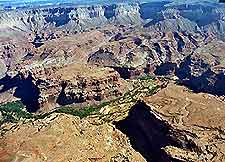Grand Canyon History Facts and Timeline
(Grand Canyon, Arizona - AZ, USA)

Recognized as a UNESCO World Heritage site and one of the best-known natural attractions in the USA, the Grand Canyon has a long history dating back to erosion by the Colorado River 17 million years ago. This erosion has exposed two billion years of the planet's geological past.
Human history does not date back quite as far, but Native American tales of the subsequent European and American arrivals are fascinating nonetheless.
Native American History
The ancient Pueblo peoples have been recognized as inhabiting the land around the Grand Canyon during the pre-Christian era. After the birth of Jesus Christ, a number of indigenous tribes occupied these lands, most notably the Cohonina, to the west, and the Sinagua, to the southeast.
Havasupai clans have inhabited the Grand Canyon since around 1200 AD and are believed to be descendants of the Cohonina. The current Havasupai Indian Reservation is a popular tourist destination and is famous for its breathtaking waterfalls.
Alternatively, tourists can visit the home of the Hualapai, which is located to the west of the canyon. The resort is wholly-owned by the Hualapai, who organize excursions such as rafting trips, helicopter rides and walks over the West Rim at Eagle Point. Of note, Eagle Point is considered to be a sacred site by the native Hualapai.
Spanish and American Exploration
The first Spanish explorations in 1540 were unsuccessful, mainly due to a lack of water and uncooperative Hopi guides. For these reasons, the canyon was off the European radar for the next 200 years. In 1776, several Spanish priests visited local Indian tribes in an attempt to convert them to Christianity.
In the 19th century, American explorers built much better relations with the natives and established a ferry crossing (Lee's Ferry) across the Colorado River. Explorations into the canyon itself were still daunting, however, and the first full expedition in Grand Canyon history was completed by a team led by Major John Wesley Powell in 1869. This epic journey lasted around ten months.
Significant Buildings
Mary Colter was among the most significant settlers in the history of the Grand Canyon. This well-known architect built Hopi House in 1905 and the Lookout Studio in 1914. Nowadays, Hopi House specializes in Native American handicrafts, especially Navajo rugs and pottery. Meanwhile, the Lookout Studio sells photographs, books and souvenirs as well as offering great views of the Bright Angel Trail. However, the Desert View Watchtower is probably her finest work, completed in 1932. The watchtower offers breathtaking views of the Colorado River and the canyon floor, enjoyed by large numbers of tourists visiting the national park each year. It is located some 27 miles / 43 km away from the Grand Canyon Village.
The Grand Canyon Village is one of the busiest settlements in the canyon and is home to Hopi House, as well as several other historic landmarks. These notable structures include the El Tovar Hotel, which was built in 1905. To this day, the four-storey hotel remains amongst the village's most luxurious properties.
At the head of the Bright Angel Trail, the 1904 Kolb Studio has been transformed from a historic photography studio into a gallery featuring art works and other exhibits. The studio was owned by the Kolb brothers, two local photographers who documented their Colorado River journeys on film in 1911.
 Recognized as a UNESCO World Heritage site and one of the best-known natural attractions in the USA, the Grand Canyon has a long history dating back to erosion by the Colorado River 17 million years ago. This erosion has exposed two billion years of the planet's geological past.
Recognized as a UNESCO World Heritage site and one of the best-known natural attractions in the USA, the Grand Canyon has a long history dating back to erosion by the Colorado River 17 million years ago. This erosion has exposed two billion years of the planet's geological past.